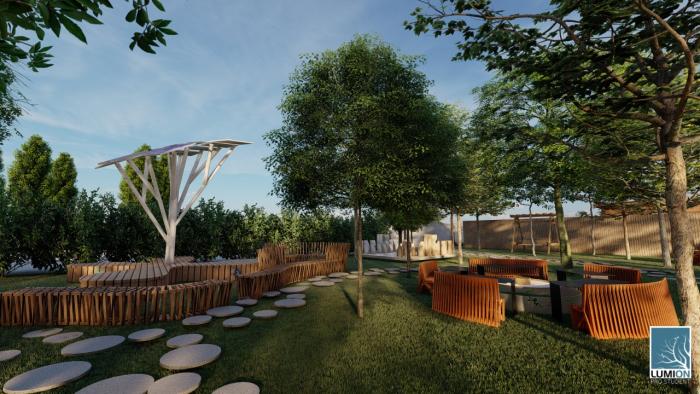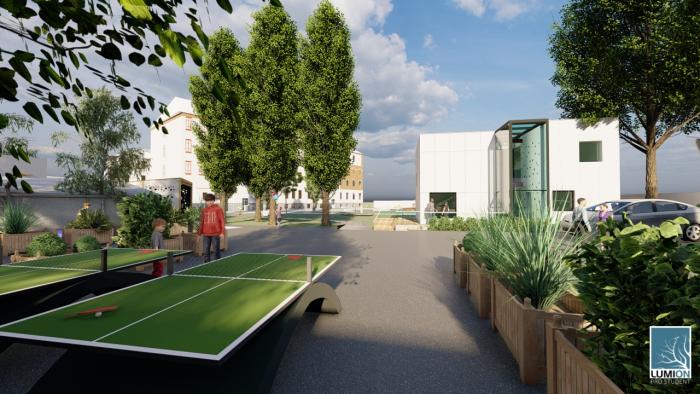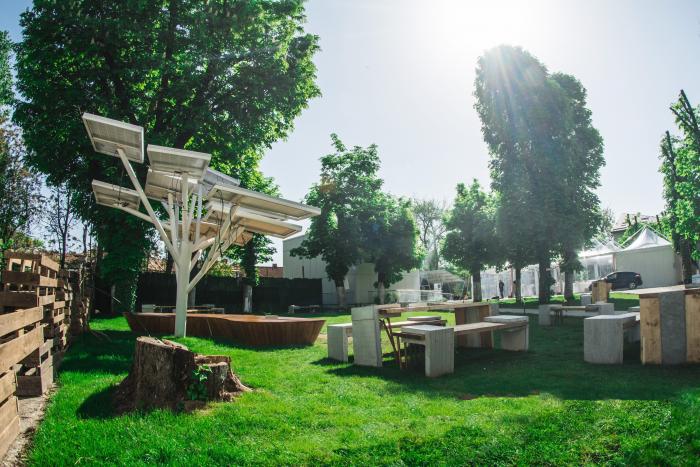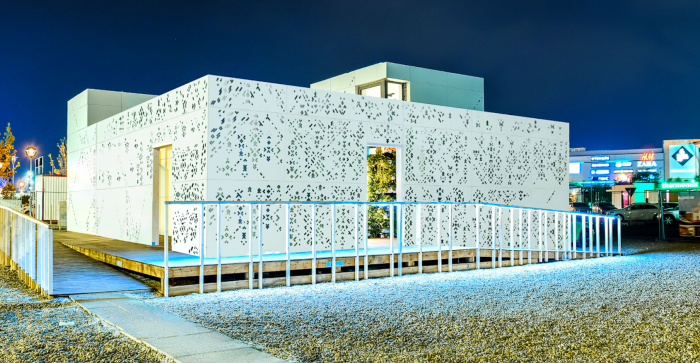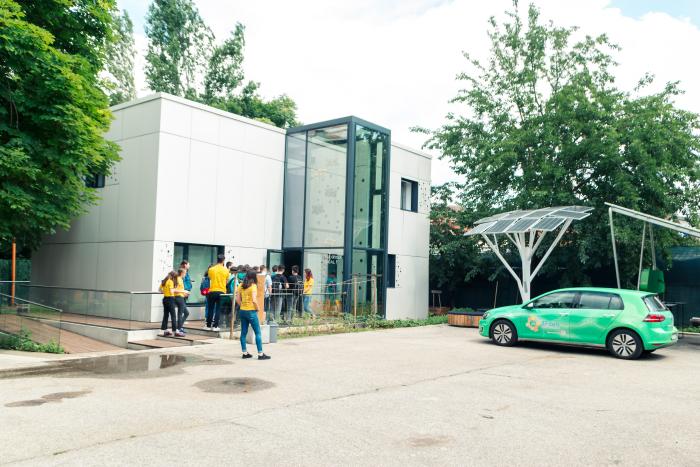I. SUMMARY INFORMATION
Project
269913
Status
Submitted
Award category
Reinvented places to meet and share
You want to submit
NEW EUROPEAN BAUHAUS AWARDS : existing completed examples
Project title
ESC
Full project title
EFdeN Sustainable City
Description
Can we choose sustainable cities if we have never experienced one? Since 2019 EFdeN has been developing a living lab that works as a prototype for future urban development. EFdeN Sustainable City has created a multidisciplinary space that will guide people and make them aware of the environment in which they live. The structure of our project consists of eight thematic areas built in an innovative way that introduce people to sustainable education.
Where was your project implemented in the EU?
Romania
București
Bulevardul Pache Protopopescu 66, București
44.426765
26.102537
București
020381
When was your project implemented?
Has your project benefited from EU programmes or funds?
No
Which programme(s) or fund(s)? Provide the name of the programme(s)/fund(s), the strand/action line as relevant and the year.
II. DESCRIPTION OF THE PROJECT
Please provide a summary of your project
Urban areas occupy 2% of the planet's land area, hosting 50% of the population, they are responsible for 75% of global energy consumption, generate 80% of CO2 emissions, and 80% of world GDP. Bucharest is the most congested city in Europe, the 5th busiest city in the world, the most polluted capital in Europe while only 7.5% of the city is occupied by green spaces, which are predominant in several parks and forests.
These issues have led us to take the initiative for tomorrow's cities and change them. In order to make a real impact, sustainability has to become accessible for the general public, otherwise, it remains merely a rich man’s toy and cannot give the building sector the influence it needs in the era of rapid urbanisation and large energy consumption.
Our vision was to create a place where you can learn to adapt in order to live in a city with access to improved innovation and education.
In EFdeN Sustainable City, we implementing 8 main elements with 30+ point of interest that represent the bases of our concept:
Sustainable housing
EFdeN 4C, EFdeN Signature
Energy
Photovoltaic trees, Electric vehicle charging station, E-dance floor, Energy-producing bicycle, Urban wind, Geothermal energy, Gravitational energy
Study and Events
Team/Individual work areas, Amphitheatre, Reading areas, Areas dedicated to astronomy
Mobility
Electrical scooter/bicycle station, Bicycle/scooter container parking
Urban farming
Green wall, Aquaponic/Hydroponic system, Led lighting for plant growth, Permaculture
Health
Ping-Pong table, Basketball court, Badminton court, Maze board, Chess, Fresh bar, Yoga and aerobic, Yurt and fountain
Recycling
Selective collection, Furniture recycled materials
Art
Stage, Water-sound collection installation, Climate change photo exhibition, The impact of clothing products on the environment
Please give information about the key objectives of your project in terms of sustainability and how these have been met
More green space:
EFden 4C House was designed to respond to problems identified in Bucharest - lack of green space in the city and urban densification.
We have chosen to integrate a greenhouse indoors to prove that you can impact these issues merely by your choice of housing and the process of building it. Furthermore, it sets a good example for public administrations. Providing green spaces for recreational and educational activities was one of the main focuses when designing the site, where we kept as much of the natural resources as possible, even planting more trees, plants and providing permaculture areas.
Environmentally friendly:
Wanting to build a house that would pollute less, we used a wooden structure and implying 20% less raw material. The EFdeN Signature House was designed for that purpose and we think in the near future we must use all possibilities to build more and more sustainably.
Both our houses are energy efficient and the Points of Interest in the Campus are built with minimum energy resources and maximum repurposed materials.
In all activities we follow the development directions proposed by the UN for 2030, adhering to the Sustainable Development Goals.
Solar energy:
Aiming to get closer to young people and offer sustainable education, we took part in the Untold and Neversea festivals with a photovoltaic tree with several relaxation benches around it equipped with sockets for phone and laptop charging. Three such PV trees are found on the current site and the whole site (including the two houses is powered by energy produced by PV’s)
Resource efficiency:
We want to showcase an efficient alternative for growing plants, such an example is the aeroponic system in the EFdeN 4C house. We brought this to our greenhouse and now we can enjoy our own culture of vegetables and fruits that live suspended with the help of automatically controlled water vapor, reducing water waste.
Please give information about the key objectives of your project in terms of aesthetics and quality of experience beyond functionality and how these have been met
The ultimate goal of the project is to inspire those who visit to seek sustainable approaches for living, whilst familiarizing them with the concept of energy efficiency. As of now, this subject is met with scepticism by the public due to its futuristic allure, making the mainstream audience stray away from concepts of living that alienate humans from their designs. With this in mind, we have envisioned EFdeN Sustainable City as a fragment of future urban areas that are easily integrable in the cities of today. We sought to maintain the main focus of the living lab on the two houses we built, emulating the image of a city whose character is given by the built structures. Consequently, the aesthetic of the campus aims to be a subtle ode to nature and human-oriented design where all points of interest use natural or recycled material.
Spacious benches around the photovoltaic trees that have integrated in the upper part, plants that blend harmoniously with the cooling system for people who choose to relax in a Solar Garden. The modular benches are designed so that two friends can socialize or work in a comfortable position.
To furtherly attract fellow citizens to this kind of living we incorporated motifs from traditional patterns, the perforations in the facade, and the summer shading of the entrance give an interesting play of lights and a cooler space. Not only is this design functional and pleasant but it proves that sustainable design can carry within itself great architectural value.
The comfort of the mind and body are key points of the campus that seeks to juxtapose: spaces with a natural and biophilic design where nature surrounds you not only due to the existence of plants but also by colour palettes inspired by nature that give the sustainable design a more humane approach; and colourful interactive areas that elevate the spirit. Such spaces are the creative and sports areas that prove how to care for the planet does not have to be a dull subject
Please give information about the key objectives of your project in terms of inclusion and how these have been met
A city for everyone
The campus is a place for recreational activities in an oasis of peace in the centre of the capital. Spaces are specially designed to host both sports and intellectual activities.
In a co-creation contest in which we offer students from outside the organization the possibility to come up with ideas for the campus, including their needs into our design. Their ideas can come to life and be implemented in our city.
For anyone interested, we offer public tours and the possibility for visitors to use the city's features. Our public consists of people of all ages and all the information is easily accessible even for the younger ones.
Board games made of repurposed materials make people of all ages curious about this place where they can develop their skills, knowledge and have fun.
Interdisciplinary Hub
It is a place where you can combine sport with meditation and learning - a healthy mind in a healthy body, a location where you can discuss your ideas with colleagues or you can sit in a quiet place to stay focused on your project, your activities, and stay motivated on tasks. The main advantage of this space is that people with all kinds of interests and professional backgrounds work together helping each other learn.
Moreover, outdoor courses and seminars are held or even basketball competitions are organized.
Creating communities
Information and awareness campaigns about renewable energy are sources for people who want a better future for their city. Hosting outdoor conferences on environmental protection and climate change or promoting campaigns with public figures about the benefits of urban mobility help popularize the concept of sustainability. Other activities include outdoor exhibitions or trivia online and offline contests.
Please give information on the results/impacts achieved by your project in relation to the category you apply for
EFdeN Sustainable City is the answer to 10 from the 17 Sustainable Development Goals 2030 with an entire series of products and activities designed not just for raising awareness and responsibility but to give real solutions for United Nations targets.
Quality education
Sustainable city and communities
Climate action
Affordable and clean energy
Industry, innovation and infrastructure
Good health and well-being
Responsible consumption and production ‘
Gender equality
Partnership for the goals
Reduced inequalities
We address 5 different public segments: students, children and teenagers, companies, and the general public. We host events, workshops and develop educational programs in a non-formal environment.
Our most valuable reach is within the student group given that most of our volunteers are students from various universities. For them, the EFdeN Sustainable city has provided a great opportunity for practical and accelerated professional and personal development. Here they are able to put into practice the information they accumulate theoretically and design spaces and Points of Interest. Moreover, the sustainable city is located on the campus of the Construction University of Bucharest where its students use the urban lab daily. Children and families are always welcome in our innovation park and they are always curious to participate in our presentation and interactive activities.
Please explain the way citizens benefiting from or affected by the project and civil society have been involved in the project and what has been the impact of this involvement on the project
The project aspires to create a creative hub for the citizens of Bucharest. But in order to design a space for the community, we also desired to include those benefiting from the project in the conceptual phase of our urban lab. In order to do so, our team launched a co-creation competition where teams enrolled to design the city of tomorrow. Their submissions are not only relevant in the scope of the contest, but also in the design process of some of the areas such as the creative area, the mobility area, the study area, and many more. Their proposals are to be taken as inspiration for future development of the Sustainable City whilst also involving the creators in the manufacturing of these Points.
As for the impact of our project, we followed two main goals. Firstly, the educational component of the project is achieved by the highly informative value of the project. Visitors do not only come here for leisure activities but also learn from our team members and from the presentations attributed to every area a great deal about energy efficiency and sustainability. However, the most valuable achievement is that those who come here learn to view sustainability as an integrated aspect of the urban space, they grow more and more accustomed to ecological alternatives and further implement them in their life or learn to seek them from authorities or in their own workspace. Secondly, the recreational component is a valuable asset of EFdeN Sustainable City due to the fact Bucharest vastly lacks green spaces and especially functional green spaces. The prototype is both a museum and a working hub, providing a space for multiple activities. Moreover, the various areas account for a pressing issue of the city: lack of active areas. Given that most parts of the city have specific activities related to them, they are only active whilst people use that facility.
Please highlight the innovative character of the project
After designing and building 2 of the world’s most sustainable homes, participating 2 times in the most important competition for solar homes, and creating some additional sustainable products, it came the time for our next stage in the mission to change cities for the better.
In the heart of Bucharest, Romania’s capital, in a place easy to reach by foot, by car, or by public transportation, there is a 4000 sqm area that we used as a blueprint for the future of our city in terms of technology and communities.
A sustainable and smart city-campus, as a pilot project for transforming cities in Romania, with 8 feature areas dedicated to the main urban challenges.
We believe that EFdeN Sustainable City with the help of companies - which benefit from visibility from the organization can continue this story to which young people have access. They then receive access to a sustainable education from us that continues with the general public. It is a beneficial circle in which sustainability lasts for generations.
We think that accelerated research on energy innovation will help future generations for a lower-carbon future. ESC is not only a prototype city but also an environment in which we try to be up to date with technological trends.
Due to a combination of technological progress, developmental priorities and rising environmental concerns, EFdeN Sustainable City intends to accelerate the decarbonisation of the energy sector. Past experiences suggest that energy transformations were driven primarily by economic opportunity and technological development, not fuel resource scarcity. The ongoing transformation is evolving in the same vein, with innovation as one of its pillars. Our strategy is to pursue power system integration in Romania by materialialising its potential. EFdeN Sustainability City (ESC) is a pilot prototype of a smart city that had ambitious goals for renewable energy development.
Please explain how the project led to results or learnings which could be transferred to other interested parties
Learning and development
We invite people to experience and learn how to have a smart and healthy lifestyle regarding innovation and technology of water supplies, waste management, renewable energy and to get familiar with the concept of ecological footprints. We give assistance to events in collaboration with information and awareness campaigns for the general public on various topics. As an outcome, people get more thoughtful and aware of the influence of each other and the feedback was valuable.
Workshops & Events
EFdeN Sustainable City calls upon new people who are struggling with environmental degradation. In addition to improving it, we create an interdisciplinary space consisting of students from various disciplines and we seek to get alternative education in order to build social sustainability. We are committed to developing attractive lands of well maintaining sustainable economic growth by way of creative workshops for renewable materials, creating some additional sustainable products, we encourage reducing your generated waste, using recycled materials, and selective collection. Workshops for children, electric cars, urban agriculture, and landscaping, team-buildings and conferences, all for education for a large public and knowledge and for better living together.
In recent years we have learned how important environmental health is. We went from the metal structure to the wooden one, from the usual finishes to the natural ones. We believe that the people who talked to us and visited our campus saw that from one year to the next, better and better solutions for sustainability appeared. We feel that we have influenced authorities, architects and public figures and it is our duty to never be satisfied with the notoriety we have reached in terms of nature protection. We just want more and more.
Is an evaluation report or any relevant independent evaluation source available?
No
III. UPLOAD PICTURES
IV. VALIDATION
By ticking this box, you declare that all the information provided in this form is factually correct, that the proposed project has not been proposed for the Awards more than once under the same category and that it has not been subject to any type of investigation, which could lead to a financial correction because of irregularities or fraud.
Yes
